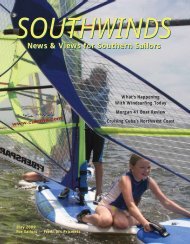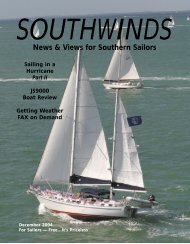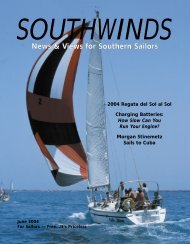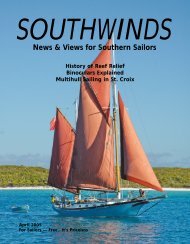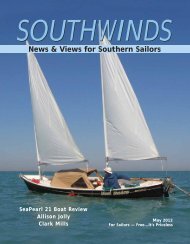Read PDF - Southwinds Magazine
Read PDF - Southwinds Magazine
Read PDF - Southwinds Magazine
- No tags were found...
Create successful ePaper yourself
Turn your PDF publications into a flip-book with our unique Google optimized e-Paper software.
SPERRY TOP-SIDER CHARLESTON RACE WEEKHitting Critical MassBy Dan DickisonThere are at least a thousand stories at large regattas—and definitely more at one as large as Sperry Top-SiderCharleston Race Week. With nearly 260 boats in attendanceand an estimated 2,000 competitors on hand at theevent on April 19-22, this annual rite of spring in theCarolina Low Country has become the country’s fastestgrowing regatta and reigns as North America’s biggest keelboatevent.The regatta’s metrics can be astounding. Some 300 volunteers(over 150 on the water) are required to make theevent run smoothly. Over 8,000 cups of Goslings Rum wereconsumed in one evening, complemented by 160 pounds oflimes used throughout the event. The economic impact onthe surrounding community exceeds $1.5-million, and theevent generates nearly 2.5-million media impressions.But metrics only capture one dimension of this four-dayextravaganza for monohulls from 20 to 80 feet LOA. To reallygrasp the ethos of Sperry Top-Sider Charleston RaceWeek, you have to peel back a few layers and look at someof those individual narratives.Let’s start with the smallest boat in the regatta, whichdrew the biggest fleet of entries (40 boats)—the Viper 640.This year was the fifth in a row that Viper Nation has madeits pilgrimage to Charleston. Fittingly, class leaders optedto designate this regatta as their Atlantic CoastChampionship this year, so more than the usual braggingrights were on the line.The Viper 640 Class has yet to be inundated by professionalsailors (unlike the Melges 24 and Melges 20 classes)and that dynamic characterized the action on CharlestonHarbor’s tide-strewn waters. Consequently, it wasn’t uncommonto see big spreads in the fleet after just the first leg of the10 races in this class. Some competitors would ascribe thatspread to the strong ebb tides, which battled with an easterlybreeze during much of the racing, resulting in moderate chopand some steep challenges for out-of-town racers (roughly 80percent of the competitors at the regatta).Among those from out of town were Bob McHugh ofFairfield, CT, who raced with his two sons, Thomas andConnor, and his friend Rob Stephan. “We’re really delightedto be here,” said McHugh while being interviewed by thelocal ABC affiliate, Charleston’s News Channel 4. “It’s agreat chance to sail with close friends and family, and havesome fun.” Both McHugh and Stephan said they weredrawn to Charleston by the reputation of the venue as muchas they were by the level of competition. Though they ultimatelyfinished in the lower third of the class, each said theyenjoyed their trip and felt it was a great experience for 16-year-old Thomas, who steered every race.Less than a mile to the east from where the Fairfielderswere getting schooled, the 33-boat Melges 24 Class wasdoing battle on Circle 3, with its annual Gold Cup at stake.At the head of that fleet, former Rolex Yachtsman of the YearThe Viper 640 Class works its way downwind in the marginal planingconditions of day 2 at Charleston Race Week. Photo by PriscillaParker.News & Views for Southern Sailors SOUTHWINDS June 2012 43



